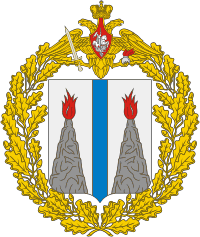
The Western Group of Forces (WGF), previously known as the Group of Soviet Occupation Forces in Germany (GSOFG) and the Group of Soviet Forces in Germany (GSFG), were the troops of the Soviet Army in East Germany. The Group of Soviet Occupation Forces in Germany was formed after the end of World War II in Europe from units of the 1st and 2nd Belorussian Fronts. The group helped suppress the East German uprising of 1953. After the end of occupation functions in 1954 the group was renamed the Group of Soviet Forces in Germany. The group represented Soviet interests in East Germany during the Cold War. Before changes in Soviet foreign policy during the early 1990s, the group shifted to a more offensive role and in 1989 became the Western Group of Forces. Russian forces remained in the eastern part of Germany after the dissolution of the Soviet Union and German reunification until 1994.
The Far Eastern Front was a front — a level of military formation that is equivalent to army group — of the Red Army during the Second World War.
The 1st Red Banner Army was a Red Army field army of World War II that served in the Soviet Far East.
A tank corps was a type of Soviet armoured formation used during World War II.

The Far Eastern Military District was a military district of the Armed Forces of the Russian Federation. In 2010 it was merged with the Pacific Fleet and part of the Siberian Military District to form the new Eastern Military District.
A rifle corps was a Soviet corps-level military formation during the mid-twentieth century. Rifle corps were made up of a varying number of rifle divisions, although the allocation of three rifle divisions to a rifle corps was common during the latter part of World War II.
The 1st Mechanized Corps was a mechanized corps of the Red Army during World War II that formed twice.
The 10th Mechanized Corps was a formation in the Soviet Red Army during the Second World War.
The 21st Rifle Division was an infantry division of the Russian Soviet Federative Socialist Republic and then the Soviet Union's Red Army, active between 1918 and 1945.
The 25th Army was a Red Army field army of World War II that served in the Russian Far East.

A fortified district or fortified region in the military terminology of the Soviet Union, is a territory within which a complex system of defense fortifications was engineered.
The 35th Rifle Division was a division of the Red Army that fought in the Russian Civil War and the Soviet invasion of Manchuria.
The 40th Rifle Division was an infantry division of the Red Army during World War II. It gained the honorific "named for Sergo Ordzhonikidze" on 14 April 1937. It fought in the engagements at Lake Khasan. On 22 June 1941, it was part of the 39th Rifle Corps, 25th Army, in the Far East Military District. The division fought in the Soviet invasion of Manchuria in 1945. In 1957, it was converted into a motorized rifle division. From 1957 to 1989 it was based at Smolyaninovo-1, Primorskiy Krai. In 1989 it was transferred to the Pacific Fleet as a coastal defence division. It was disbanded in 1996.

The Primorsky Military District was a military district of the Soviet Armed Forces that existed in from 1945 to 1953. Formed from the headquarters of the 1st Far East Front after the end of World War II, the district controlled troops on the territory of Primorsky Krai, North Korea and the Kwantung Peninsula. It was disbanded in 1953 and the territory became part of the Far Eastern Military District.
The 11th Mechanized Corps was a mechanized corps of the Red Army, formed twice. The corps was first formed as one of the original two Red Army mechanized corps from the 11th Rifle Division in Leningrad. In 1934 it was transferred to the Transbaikal Military District and in 1938 became the 20th Tank Corps. The corps was reformed in March 1941 in western Belarus. After the German invasion of the Soviet Union, the understrength corps was destroyed in the Battle of Białystok–Minsk.

Ivan Konstantinovich Morozov was a major general of the Red Army during the Second World War.
The 9th Air Army was a military formation of the Soviet Air Forces, active from August 1942 until April 1957, which operated in the Far East.

The Harbin–Kirin Operation was a military operation of the Red Army against the Japanese Forces during the Soviet–Japanese War. Conducted from August 9 to September 2, 1945, by troops of the 1st Far Eastern Front and Pacific Fleet with the goal of defeating the Kwantung Army in eastern Manchukuo and northern Korea. Part of the Manchurian Strategic Offensive Operation.






